Inquiry Now
Email: [email protected]
WhatsApp:+86 170 766 13145






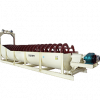
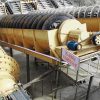
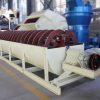
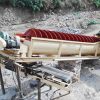


Spiral Classifiers are widely used in the distribution of ore in closed circuits with ball mill in mining processing, in order to get a certain degree fineness of ore particles, meanwhile increasing the efficiency of grinding. This machine can also be use
Spiral Classifiers are widely used in the distribution of ore in closed circuits with ball mill in mining processing, in order to get a certain degree fineness of ore particles, meanwhile increasing the efficiency of grinding. This machine can also be use



According to the height of the overflow weir, the position of the spiral in the water tank is different from the height of the slurry surface, the spiral classifier can be divided into three types: high weir type, low weir type and submerged type.
High weir type spiral classifier. The overflow weir position of the high weir type spiral classifier is usually higher than the bearing center at the lower end of the screw shaft, and lower than the upper edge of the overflow end spiral, so the area of the settlement area is larger than that of the low weir type spiral classifier, and the weir height is also higher. It can be adjusted within a certain range, that is, the area of the sedimentation zone can be slightly changed according to the classification requirements, so as to adjust the classification particle size.
Low weir type spiral classifier. The overflow weir of the low-weir spiral classifier is often lower than the center of the bearing at the overflow end, so the area of the settlement area is too small. The overflow production capacity is too low, and the agitation of the spiral to the slurry surface is large, so in actual production only It is used for flushing sand ore with little mud content and dehydration of coarse particles, and is rarely used in grading process.
Submerged spiral classifier. The overflow end of the submerged spiral classifier generally has 4-5 turns of spiral blades, and all the spiral blades are submerged under the liquid level in the settling area, so the area of the settling area is large and the classification pool is deep.
Due to the difference in structure between the high weir type and the submerged spiral classifier, their functions are also different. The high-weir spiral classifier is more suitable for separating coarse grains larger than 0.15mm, and is often used in the first stage of grinding; while the submerged spiral classifier has a stable classification surface, high overflow output, and fine particle size. Therefore, it is more suitable for separating overflow products with a particle size of less than 0.15mm, and it is often combined with the grinding machine in the second stage of grinding.
Heavy duty, long working life.
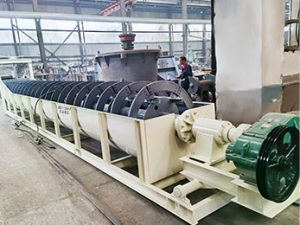
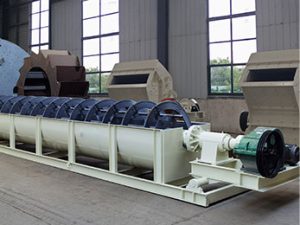

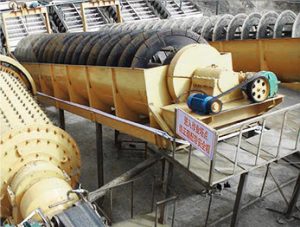
Low power cosumption,high classifying efficiency.
Powerful manual control and electric control lifting device.
Wide choice of weir height, rigid tank and substructure.
Different solid granularities have different gravity and thus have different dropping speed. The fine ore granularities floating in the water will overflow and the big ones will sink to the bottom and discharge from the upper part by spiral pushing. It can filter the granularities from the machine and then spin the rough particles to charging part by spiral vane and discharge the fine granularities from the overflow pipe. The base of the machine adopts a channel steel and the body adopts welded steel plate. The water inlet of spiral axle and axle head adopt pig iron cover for wear proofing and long life operation. The lifting equipment has two types, manual control and electric control.

| Model | Spiral diameter(mm) | Speed of Spiral(r/min) | Power (kw) | Slope (°) | Power(KW) | |
| Sand Return (t/h) | Overflow (t/h) | |||||
| FG500 | 500 | 8-12.5 | 6-11 | 32 | 12-18 | 1.1 |
| FG750 | 750 | 6-10 | 11-24 | 65 | 12-18 | 3 |
| FG1000 | 1000 | 5-8 | 25-45 | 110 | 12-18 | 5.5 |
| FG1200 | 1200 | 4-6 | 50-80 | 155 | 12-18 | 7.5 |
| FG1500 | 1500 | 4-6 | 70-115 | 235 | 12-18 | 7.5 |
| FG1800 | 1800 | 2.5-6 | 100-190 | 310 | 12-18 | 11 |
| FG2000 | 2000 | 3.6-5.5 | 160-230 | 400 | 12-18 | 15 |
*The output will vary according to different materials, feed particle size and other factors